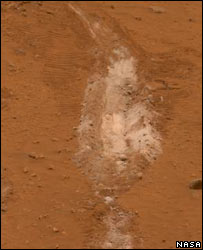The robotic vehicle revealed a material that could only form in the presence of hot water, that is, a hot corner - a volcano crater or a geyser - where bacteria could survive

An interesting disclosure yesterday (Monday) at the American Geophysical Union (AGU) meeting, from the mouth of Stephen Squires from Cornell University, who is the chief scientist in the Spirit and Opportunity Mars rover project. Apparently a material discovered by the robot Spirit, in an excavation created unintentionally, due to dragging a damaged wheel. Squires describes this as one of the most significant discoveries since the arrival of the robotic vehicles on the surface of Mars. The scientists believe that a patch on the ground that was exposed due to the dragging of the ground, contains evidence of a period in the history of Mars when the place was warm and at least in terms of conditions, bacteria, if formed there, could survive and thrive for a long time.
The discovered deposit was probably formed when hot water springs or steam streams came into contact with the volcanic rocks. On Earth, these are the places where bacteria are found, Squires said in his lecture at the conference. "We are very excited about the discovery." said.
This is a discovery in which the share of luck was large. The Spirit was traveling with one of its wheels broken and therefore dug a little into the Martian soil as it progressed. In May of this year, the scientists analyzing the images of the Martian robots noticed that in the groove that was created there was a material that looked brighter than usual. The scientists directed the robot's chemical analysis devices to the exposed materials and the nearby rocks in order to search for additional clues to a similar material in the area.
The researchers came to the conclusion that the bright material could have been formed in one of two ways - one hypothesis is that the spirit exposed a deposit left over from a kind of heat, created when the water dissolved the iron dioxide particles in one spot and erupted from another spot. The classic example of this on Earth is the phenomenon of geysers. The second possibility put forward by the scientists from Cornell and NASA, is that Spirit traveled over the crater of an extinct volcano, which an acidic flow burst from the cracks in the rocks and decomposed them into all their mineral components, except for the nitrogen dioxide.
The search for life
"Whether one hypothesis is correct or the other service, the likelihood of Mars' ability to sustain life in the past is quite similar," says Prof Squires in an interview with the BBC. "What is special about these deposits is that not only did the hot water provide an environment where bacteria could form, but the separation of the nitrogen dioxide can help preserve life. added

2 תגובות
To my father, the editor of the scientist website, the astronauts on the space station celebrate Christmas
The beat is really, really beautiful...
There is a question:
Can you publish more scientific articles that are a little more detailed.. today??????
Thank you dark chocolate